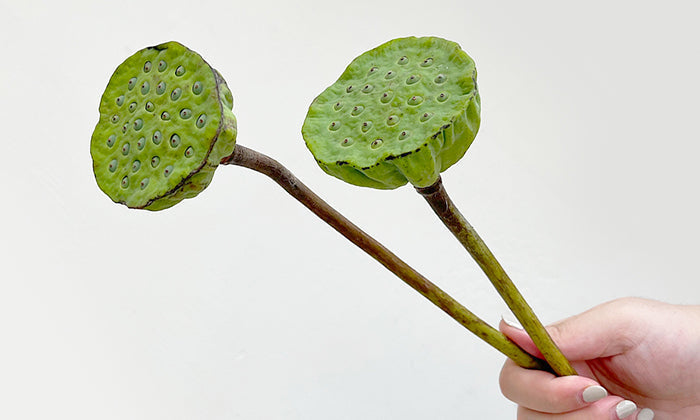
To the untrained eye, the Lotus Flower is like any other bloom. In fact, it’s often mistaken for the Water-Lily! But trust us when we say, it’s truly in a league of its own— dominating many religions, anddepicted beside the divine. Just what about the Lotus Flower sets it apart from the rest? We’ll be unearthing it all, so read on to find out more about this remarkable bud!
The Life Story Of Lotus Flowers
First things first, fossil records show that the Lotus Flower, an aquatic plant that belongs to the Nelumbonaceae family, has been in existence for millions of years. Though its origins can’t be fully traced, the Lotus Flower is believed to have survived theIce Age. Amazingly, these flowers can now be found across the globe, in both tropical and harsher climates.Talk about a strong will to live!
What’s even more amazing is that all parts of the Lotus Flower are edible— withsome even boasting health properties— resulting in their cultivation and prevalent use in folk remedies. Truth is, you might’ve eaten its rhizomes and seeds before, either in the form of lotus root soup or in Lian Zi Xin!

Lotus Flower Varieties
Though there are over 50 varieties of Lotus Flowers, they can be categorised into two main species: The Nelumbo Lutea and Nelumbo Nucifera.
Both are emergent aquatic plants, but the Nelumbo Lutea, better known as the yellow Lotus or American Lotus, is only native to… you guessed it, North America! Sadly, the population has taken quite a hit due to habitat destruction, and they’ve since become an endangered species.
Meanwhile, the Nelumbo Nucifera is far more protected since they’re revered for their rhizomes and seeds. In fact, they’ve seen widespread growth and can be found in Southeast Asia, Northern and Eastern Australia as well as Russia.

Symbolism of Lotus Flowers
With such a long lifespan, it’s no surprise that the Lotus Flower holds great symbolic weight, which is further fueled by its unique life cycle. What do we mean by this? Well, unlike other flowers, it grows best in mud. Once it blooms, it submerges every night into the river water, and then re-blooms the morning after, entirely dirt-free!
For many cultures, this process of “resurrection” is akin to rebirth and spiritual enlightenment. That’s why the Lotus Flower is also known as the Flower of Life and considered to be sacred. Think of the dirt as the temptation of evil, of which we can break free from after gaining awareness. As such, the Lotus Flower is often depicted alongside the divine.
Lotus Flower And Its Significance In Hinduism
In Hinduism, there is astory where the Lotus grew from the navel of Vishnu, the creator of the world. And within the flower’s centre sat his servant Brahma. At Vishnu’s command to “Create the World”, Brahma split the Lotus Flower into three, forming the Earth, the Sky, and the Heavens.

Lotus Flower And Its Significance In Buddhism
The Lotus Flower is arguably the most important symbol in Buddhism. Just like how the Lotus rises up from the depths of muddy waters, so can one rise, emerge from the challenges, and attain enlightenment.
It’s said that Buddha himself appeared on top of a floating Lotus, and where he stepped bloomed a Lotus Flower.
“As a lotus flower is born in water, grows in water and rises out of water to stand above it unsoiled, so, I, born in the world, raised in the world, having overcome the world, live unsoiled by the world.”
– Buddha
Lotus Flower Colours And Meanings
Aside from its ties to divinity, the Lotus Flower stands for many other things: Patience, mysticism, purity, wealth, prosperity, and fertility. Much like the other blooms, their meanings and interpretations vary depending on thecolour.

Meaning Of White Lotus Flowers
The pure white Lotus Flower, a.k.a. “Womb of the World”, often symbolises the awakened mind. Because it’s so closely associated with purity, spiritual perfection, illumination and faith, white Lotus Flowers are mostly used for religious ceremonies.

Meaning Of Pink Lotus Flowers
Pink Lotus Flowers are said to be the true flower of the Buddha. A budding pink Lotus Flower symbolises a person whose awareness is beginning to expand, while one that has reached full bloom represents a full sense of enlightenment.

Meaning Of Yellow Lotus Flowers
Also called the golden Lotus in Buddhism, the yellow Lotus Flower symbolises joy, openness, hospitality, and spiritual ascension.
Meaning Of Red Lotus Flowers
The colour red is commonly associated with energy, love and passion. A red Lotus Flower is no different and is seen as the representation of romantic passion, and selfless love. A go-to flower if you’re looking to confess!
Meaning Of Blue Lotus Flowers
The blue Lotus Flower often symbolises clarity of thought, knowledge and intelligence in Buddhism. It’s not to be confused with the Egyptian Lotus, which is often called the Blue Lotus… that happens to be a Water Lily, another aquatic plant. Confusing, we know!
Just remember this — the Egyptian blossom contains bothApomorphine and Nuciferine, chemicals that make it a natural aphrodisiac, sleep aid, and anxiety reliever. Very different from your typical blue Lotus.

Meaning Of Purple Lotus Flowers
The purple Lotus Flower is a symbol of mysticism. Its eight petals signify the Noble Eightfold Path to awakening, which happens to be one of the main teachings of the Buddha.

Lotus Flower Fun Facts
- A Lotus can still flower even when the Lotus seed has been dormant for years. The oldest germination recorded is from seeds that are 1,300 years old.
- A Lotus can only grow up to 125cm (50 inches) in height, but its leaves can grow as wide as 3 metres (10 feet).
- Ancient Egyptians believed that the dead can be transformed into a Lotus Flower.
- The pink Lotus Flower is the national flower for both India and Vietnam.
- China, Japan and Korea have festivals dedicated to the Lotus.
- The Lotus produces a fibre that can be woven into fabric. Yay to a cruelty-free alternative!
- Around 70% of Lotus farmed for human consumption is harvested in China.

Lotus Flower 101
While Lotus Flowers are hardy, they’re less so when cut. Why, you ask? Once a Lotus Flower has been cut, the stem begins a process of “self-healing” where it will close up. It’s likely that the bloom will only last about 2-3 days before its condition deteriorates. If you want to extend its longevity, here are some tips:
How To Care For Your Cut Lotus Flowers
Lotus stems are brittle and prone to snapping, so handle them with extra care! Check for signs of wrinkling or softness on their petals. These are indicators that tell you how old the bloom is.
- Once they’ve arrived, hold them over a bucket when you take them out to allow the water to drain away.
- Cut the excess length away, and make sure to submerge at least two-thirds of the stem in water. Avoid using floral foam.
- Do not get water on the Lotus Flower petals as much as possible. This will help to reduce the chances of blemishes forming.
- Try keeping the guard petals on. This will help keep the Lotus Flower from wilting for an approximated two days.
- Lotus Flowers do not do well in cold temperatures, so keep them in a warm area.
Where Is The Best Place to Keep A Lotus Flower?
Lotus Flowers can handle some shade, but they need full sunlight with a temperature of at least 23°C for them to bloom into their best. Remember to keep them hydrated by placing the flowers into a clean vase with water. If you need a crash course on general cut flower care, remember to giveour flower care guide a read!
And once they wilt, you can dry the pods and use them as decor too!
Lot-us Rise For The Conclusion!
With their tenacious spirit and hardy nature, Lotus Flowers are certainly divine, wouldn’t you say? Though the cut versions are short-lived, they still make for ideal gifts to convey your love, support and encouragement!
Loved this read? Check out ourFlower Dictionary for more flower fun facts.



